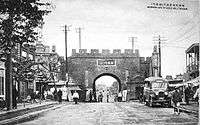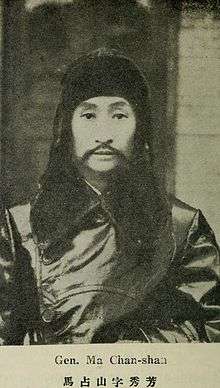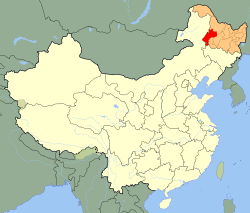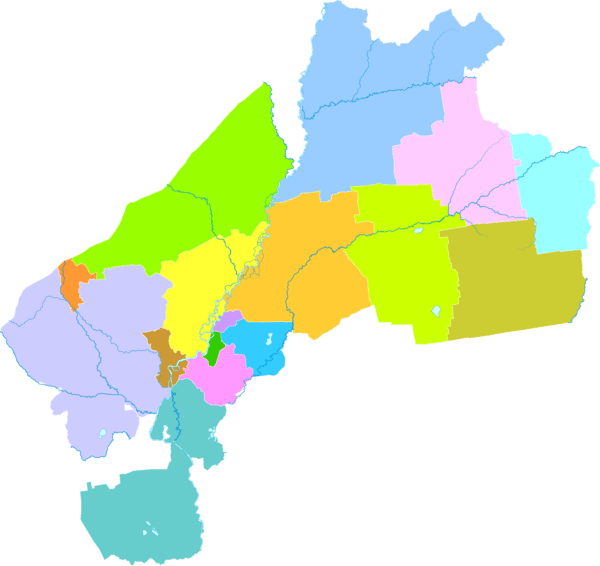Qiqihar
| Qiqihar | |||||||||
| Traditional Chinese | 齊齊哈爾 | ||||||||
|---|---|---|---|---|---|---|---|---|---|
| Simplified Chinese | 齐齐哈尔 | ||||||||
| Postal | Tsitsihar | ||||||||
| |||||||||
Qiqihar (simplified Chinese: 齐齐哈尔; traditional Chinese: 齊齊哈爾; pinyin: Qíqíhāěr; Manchu: Cicigar ᠴᡳᠴᡳᡤᠠᡵ) is one of the 13 Larger Municipalities in China, and the second largest city in the Heilongjiang province, China. The built-up (or metro) area made up of Longsha, Tiefeng and Jianhua districts had 979,517 inhabitants, while the total population of the prefecture-level city was 5,367,003 at the 2010 census.[1] These are mainly Han Chinese, though the city is also home to thirty-four minorities including Manchu, Daur, and Mongolians.[2] Close to Qiqihar are numerous wetlands and the Zhalong Nature Reserve, famous in China for being home to numerous red-crowned cranes.
History
Early History

Qiqihar is one of the oldest cities in the northeast of China. The region was originally settled by nomadic Daur and Tungus herdsmen. Qiqihar is a Daur word, which means border or natural pasture. [3] The city's original name was Bukui (卜奎), the Chinese transcription of a Daur word meaning "auspicious".[4] The city's oldest mosque, the Bukui Mosque, actually predates the foundation of the city itself by seven years.[5] As the Czarist Russian eastward advance to the Pacific coast, Qiqihar became a major garrison center in 1674. In 1691, a stronghold was constructed in Qiqihar because of the Qing government's campaigns against the Mongols.[6] Around 1700 it was a center for Russo-Chinese trade. A military depot with barracks and an arsenal was set up there, and many convicted criminals were exiled to the area. Heilongjiang Martial domiciled in Qiqihar City in 1699.[3] The Qing Dynasty had initially intended to keep far-northern Heilongjiang province as a semi-pastoral area, separate from the wider Chinese agricultural economy, so it did not allow seasonal urban migrants, such as those from Hebei and Shandong who wished to participate in the Qiqihar fur trade, to own acres and transform the land. After the Russian Empire seized Outer Manchuria according to the unequal treaties of Aigun and Beijing, the Qing made the decision to lift the various restrictions it placed on Northeast China and on Heilongjiang residency in particular, in 1868, 1878, and 1904. It enlisted Han people to help teach the local Solon people farming techniques, providing materials and tax exemptions in order to convert them from hunting.[7] In 1903, The completion of the Chinese Eastern Railway made Qiqihar a center for communications between China and Russia. A network of lines radiating from Qiqihar was extended into the northwestern part of Heilongjiang Province including Jiagedaqi and Manzhouli in the late 1920s.
Second Sino-Japanese War Period

In 1931, Japan used a false flag attack, remembered as the September 18 Incident, to justify moving its Guandong Army to capture major cities in Northeast China that month, starting with Shenyang, Changchun, then Jilin City. General Ma Zhanshan was ordered to act as Governor and Military Commander-in-chief of Heilongjiang Province on October 10, 1931. General Ma declined a Japanese ultimatum to surrender Qiqihar on November 15. However, after the loss of Jiangqiao Campaign, the Japanese began their occupation of Qiqihar on November 19, 1931.[8] Liaoning fell in December, and Harbin in February; the puppet Manchukuo government of the Japanese-occupied territory under General Zhang Jinghui established Qiqihar as its administrative center and of Longjiang province. Qiqihar became a major military base for Guandong Army and its economic importance also grew rapidly. During the occupation, the Imperial Japanese Army established Unit 516 in Qiqihar for research into chemical warfare.[9] A major mustard gas tank left over from the Second Sino-Japanese War buried underground was accidentally damaged in August 2003, causing 43 injuries and one death.[10]
Modern Era
After the defeat of Japan, the Democratic Regime Qiqihar Municipal Government was established, under the administration of Nenjiang Province. Japanese forces in Northeast China surrendered to the Soviet Union while Japanese forces in the rest of China surrendered to the United States.[11][12] From March to May, Soviet troops progressively withdrew from their positions, giving the People's Liberation Army more notice than the National Revolutionary Army so that the former could occupy more positions in the context of the Chinese Civil War.[13] Qiqihar was controlled by the Communists on April 24, 1946, along with other important regional cities like Changchun, Jilin City, and Harbin. Qiqihar was established as the capital of Heilongjiang Province after the foundation of People's Republic of China in 1949. However, since Songjiang Province was merged into Heilongjiang Province, the provincial capital was transferred to Harbin in 1954. During the first five-year plan of China from 1951 to 1956, many factories including Beiman Special Steel Co. and China First Heavy Industries were aid-constructed by the Soviet Union in Fularji District, making Qiqihar an important center of equipment manufacturing industry in Northeast China. In 1984, Qiqihar was designated to be one of the 13 Larger Municipalities in China by the General Office of the State Council.[14]
Sports
The largest sports venue by capacity in Qiqihar is the Hecheng Stadium, which is used mostly for football matches.
There is an indoor speed skating arena,[15] one of five in China.
Qiqihar is one of the cities in which China Bandy Federation explores the potential for bandy development.
Geography
Qiqihar is located along the middle and lower reaches of the Nen River and the hinterland of Songnen Plain, which is adjacent to the Greater Khingan Range and Hulunbuir Prairie. Bordering prefecture cities are:
- Baicheng, Jilin (S)
- Daqing (E)
- Heihe (N)
- Hulunbuir, Inner Mongolia (W)
- Suihua (NE)
- Hinggan League, Inner Mongolia (W)
The city's metro area is located 359 km (223 mi) from the provincial capital of Harbin, 282 km (175 mi) from Baicheng, 139 km (86 mi) from Daqing, and 328 km (204 mi) from Suihua. The city's metro area is located at latitude 47° 00'−47° 52' N and longitude 123° 33'−124° 28' E. The total area under the city's jurisdiction is 42,289 km2 (16,328 sq mi). The region's elevation above sea level is generally between 200 m (660 ft) and 500 m (1,600 ft).[16]
Climate
Qiqihar has a cold, monsoon-influenced, humid continental climate (Köppen Dwa), with four distinct seasons. It has long, bitterly cold, but dry winters, with a 24-hour average in January of −18.6 °C (−1.5 °F). Spring and fall are mild, but short and quick transitions. Summers are very warm and humid, with a 24-hour average in July of 23.2 °C (73.8 °F). The average annual precipitation is 415 millimetres (16.3 in), with over two-thirds of it falling from June to August. The annual mean is 3.95 °C (39.1 °F). With monthly percent possible sunshine ranging from 56% in July to 73% in February, the city receives abundant sunshine, with 2,839 hours of bright sunshine annually. Extreme temperatures have ranged from −39.5 °C (−39 °F) to 42.1 °C (108 °F).[17]
| Climate data for Qiqihar (1971−2000) | |||||||||||||
|---|---|---|---|---|---|---|---|---|---|---|---|---|---|
| Month | Jan | Feb | Mar | Apr | May | Jun | Jul | Aug | Sep | Oct | Nov | Dec | Year |
| Average high °C (°F) | −12.4 (9.7) |
−6.5 (20.3) |
2.7 (36.9) |
13.1 (55.6) |
21.2 (70.2) |
26.2 (79.2) |
28.0 (82.4) |
26.3 (79.3) |
20.3 (68.5) |
11.1 (52) |
−1.1 (30) |
−10.1 (13.8) |
9.9 (49.8) |
| Average low °C (°F) | −23.7 (−10.7) |
−19.3 (−2.7) |
−10.1 (13.8) |
−0.2 (31.6) |
8.0 (46.4) |
14.9 (58.8) |
18.5 (65.3) |
16.6 (61.9) |
9.1 (48.4) |
−0.2 (31.6) |
−11.3 (11.7) |
−20.4 (−4.7) |
−1.5 (29.3) |
| Average precipitation mm (inches) | 1.5 (0.059) |
1.7 (0.067) |
5.6 (0.22) |
17.3 (0.681) |
29.6 (1.165) |
67.1 (2.642) |
128.8 (5.071) |
90.0 (3.543) |
45.5 (1.791) |
20.1 (0.791) |
4.4 (0.173) |
3.6 (0.142) |
415.2 (16.345) |
| Average precipitation days (≥ 0.1 mm) | 3.5 | 3.0 | 3.4 | 5.1 | 7.2 | 11.2 | 13.7 | 11.2 | 9.1 | 5.1 | 3.5 | 4.9 | 80.9 |
| Average relative humidity (%) | 67 | 58 | 47 | 46 | 46 | 62 | 73 | 73 | 66 | 57 | 60 | 67 | 60.2 |
| Mean monthly sunshine hours | 190.6 | 208.6 | 260.4 | 248.5 | 282.7 | 282.2 | 269.4 | 271.7 | 247.3 | 227.6 | 185.4 | 164.9 | 2,839.3 |
| Percent possible sunshine | 70 | 73 | 71 | 61 | 61 | 60 | 56 | 62 | 66 | 68 | 66 | 63 | 64 |
| Source: China Meteorological Administration[18] | |||||||||||||
Subdivisions
Qiqihar is divided into 16 divisions: 7 districts (区 qū), 8 counties (县 xiàn) and 1 county-level city (县级市 xiànjí shì).
| Map | ||||||
|---|---|---|---|---|---|---|
| # | Name | Hanzi | Hanyu Pinyin | Population (2010 est.) | Area (km²) | Density (/km²) |
| 1 | Longsha District | 龙沙区 | Lóngshā Qū | 354,987 | 283 | 1,254 |
| 2 | Jianhua District | 建华区 | Jiànhuá Qū | 292,579 | 81 | 3,612 |
| 3 | Tiefeng District | 铁锋区 | Tiěfēng Qū | 331,951 | 695 | 478 |
| 4 | Ang'angxi District | 昂昂溪区 | Áng'ángxī Qū | 80,109 | 623 | 129 |
| 5 | Fularji District | 富拉尔基区 | Fùlā'ěrjī Qū | 256,159 | 375 | 683 |
| 6 | Nianzishan District | 碾子山区 | Niǎnzishān Qū | 72,151 | 290 | 249 |
| 7 | Meilisi Daur District | 梅里斯达斡尔族区 | Méilǐsī Dáwò'ěrzú Qū | 165,852 | 1,948 | 85 |
| 8 | Nehe City | 讷河市 | Nēhé Shì | 625,892 | 6,664 | 94 |
| 9 | Longjiang County | 龙江县 | Lóngjiāng Xiàn | 572,764 | 6,197 | 92 |
| 10 | Yi'an County | 依安县 | Yī'ān Xiàn | 480,035 | 3,780 | 127 |
| 11 | Tailai County | 泰来县 | Tàilái Xiàn | 302,027 | 4,061 | 74 |
| 12 | Gannan County | 甘南县 | Gānnán Xiàn | 368,734 | 4,384 | 84 |
| 13 | Fuyu County | 富裕县 | Fùyù Xiàn | 276,537 | 4,335 | 64 |
| 14 | Keshan County | 克山县 | Kèshān Xiàn | 403,175 | 3,632 | 111 |
| 15 | Kedong County | 克东县 | Kèdōng Xiàn | 264,285 | 2,083 | 127 |
| 16 | Baiquan County | 拜泉县 | Bàiquán Xiàn | 519,766 | 3,569 | 146 |
Economy
In 2010, Qiqihar's GDP grew 18.5% from the previous year to RMB 85.26 billion, ranking third after Harbin and Daqing in the province.[19] Qiqihar is part of Harbin-Daqing-Qiqihar Industrial Corridor, which is a comprehensive industrial base with a focus on petrochemicals, energy, autos, electronics, medicine and food. Equipment manufacturing and food and beverages are the two pillar industries in the city. Animal husbandry is a pillar of Qiqihar's agricultural sector. Qiqihar is also a major corn production hub in Heilongjiang Province.[20] Qiqihar is home to Qiqihar Heavy CNC Equipment Co Ltd, Qiqihar No.2 Machine & Tool Works and Beidacang Group. Qiqihar Heavy CNC Equipment Co Ltd, formerly known as Qiqihar First Machine & Tool Works, was first established in 1950. It has an annual equipment manufacturing capacity of 1,500 units. Qiqihar No.2 Machine & Tool Works is a leading equipment manufacturer in China. Beidacang Group is a large distilled liquor producer in Heilongjiang Province. It was established in 1914 and converted into a private company in 1999.
Tourism
- Zhalong Nature Reserve
- Longsha Park
- Zen Monastery
- Labor Lake
- New cultural sites at Ang'angxi
- Wan Shin Buddhist Temple
- St. Michael's Cathedral
- Mingyue Island
Sports
It has an indoor speed skating arena, Indoor Ice Rink, as one of four in China.
Qiqihar was previously home to an Asia League Ice Hockey team which used the snow leopard as a mascot. The team later became Changchun Fuao, relocating to Changchun, Jilin Province. Qiqihar played host to the 2007 IIHF World Championships Division I, Group A.
Education
Transport
Qiqihar has a domestic airport (Qiqihar Airport), a railway station, a bus network, and taxis. Qiqihar is a railway transportation hub in western Heilongjiang Province and northeastern Inner Mongolia. Trains from Qiqihar Railway Station connect the city with Harbin, Beijing, Dalian, Hangzhou, Xi'an and several other major cities in China. Qiqihar Airport, 13 km (8.1 mi) from Qiqihar's downtown area, operates daily flights to Beijing, Guangzhou, Shanghai and other major cities in China. In the district of Ang'angxi, the Harbin-Manzhouli Railway intersects with the Qiqihar-Bei'an Railway.
The new Harbin-Qiqihar High-Speed Railway (哈齐高铁) is scheduled to open in August 2015; it will provide frequent high-speed service to Harbin, as well as some direct trains to Beijing.[21]
Gallery
 The old station building, now used for first class
The old station building, now used for first class The old station building
The old station building The new station building
The new station building
Sister Cities
 New Castle County, Delaware, USA
New Castle County, Delaware, USA Utsunomiya, Japan
Utsunomiya, Japan Goyang, South Korea
Goyang, South Korea 10th of Ramadan City, Egypt
10th of Ramadan City, Egypt Krasnoyarsk, Russia[22]
Krasnoyarsk, Russia[22]
Notes
- ↑ 2010年齐齐哈尔市第六次全国人口普查主要数据公报(Sixth National Population Census of the People's Republic of China)
- ↑ "Archived copy". Archived from the original on October 17, 2007. Retrieved December 29, 2009.
- 1 2 "Survey of the City". Qiqihar Municipal Government. Archived from the original on October 17, 2007. Retrieved 18 August 2012.
- ↑ "齐齐哈尔自然环境", Xinhua News, 2006-08-25, retrieved 2010-09-11
- ↑ "卜奎清真寺", Qiqihar News, 2005-06-27, retrieved 2010-09-11
- ↑ 齐锡鹏 (1989). 齐齐哈尔历史述略. 黑龙江人民出版社Heilongjiang People's Press. ISBN 978-7-207-01417-7.
- ↑ Shan, Patrick Fuliang (June 2006). "Ethnicity, Nationalism, and Race Relations: The Chinese Treatment of the Solon Tribes in Heilongjiang Frontier Society, 1900-1931". Asian Ethnicity. 7 (2): 185–187.
- ↑ Matsuzaka, The Making of Japanese Manchuria, 1904-1932
- ↑ "Mustard Gas Victims Prepare Case Against Japan", China.org.cn, 2004-06-28, retrieved 2010-09-11
- ↑ "Diplomatic row over poison gas", The Guardian, 2003-08-13, retrieved 2010-09-11
- ↑ Zarrow, Peter Gue. [2005] (2005). China in War and Revolution, 1895–1949. Routledge. ISBN 0-415-36447-7. pg 338.
- ↑ LTC David M. Glantz, "August Storm: The Soviet 1945 Strategic Offensive in Manchuria". Leavenworth Papers No. 7, Combat Studies Institute, February 1983, Fort Leavenworth Kansas.
- ↑ Heinzig, Dieter (2004). The Soviet Union and Communist China, 1945-1950: The Arduous Road to the Alliance. M.E. Sharpe. p. 100.
- ↑ "国务院关于批准唐山等市为"较大的市"的通知".
- ↑ Rink card of: Indoor Icerink Qiqihar
- ↑ "Geography and Topography". Qiqihaer Municipal Government. Archived from the original on October 17, 2007. Retrieved 18 August 2012.
- ↑ "黑龙江省齐齐哈尔市地理位置及气候资源概况". 图骥网. Retrieved 2014-01-13.
- ↑ 中国地面国际交换站气候标准值月值数据集(1971-2000年) (in Chinese). China Meteorological Administration. Archived from the original on September 21, 2013. Retrieved 2010-05-04.
- ↑ Statistics Report on National Economy and Social Development of Qiqihar City in 2010 Archived April 26, 2012, at the Wayback Machine.
- ↑ Profiles of China Provinces, Cities and Industrial Parks
- ↑ 哈齐客运专线更名哈齐高铁 成为我省首个高速铁路线路 Archived March 4, 2016, at the Wayback Machine., 哈尔滨日报, 2015-7-30
- ↑ As of today, Krasnoyarsk City Administration has concluded protocols of intent and agreements on cooperation with the following foreign cities:


